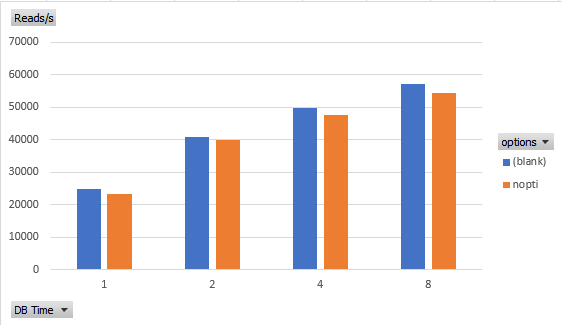By Franck Pachot
.
The Spectre and Meltdown is now in the latest Oracle UEK kernel, after updating it with ‘yum update’:
[opc@PTI ~]$ rpm -q --changelog kernel-uek
| awk '/CVE-2017-5715|CVE-2017-5753|CVE-2017-5754/{print $NF}' | sort | uniq -c
43 {CVE-2017-5715}
16 {CVE-2017-5753}
71 {CVE-2017-5754}As I did on the previous post on AWS, I’ve run quick tests on the Oracle Public Cloud.
Physical reads
I’ve run some SLOB I/O reads with the patches, as well sit KPTI disabled, and with KPTI, IBRS and IBPB disabled.
And I was quite surprised by the result:
DB Time(s) : 1.0 DB CPU(s) : 0.4 Read IO requests : 23,335.6 nopti
DB Time(s) : 1.0 DB CPU(s) : 0.4 Read IO requests : 23,420.3 nopti
DB Time(s) : 1.0 DB CPU(s) : 0.4 Read IO requests : 24,857.6
DB Time(s) : 1.0 DB CPU(s) : 0.4 Read IO requests : 25,332.1
DB Time(s) : 2.0 DB CPU(s) : 0.7 Read IO requests : 39,857.7 nopti
DB Time(s) : 2.0 DB CPU(s) : 0.7 Read IO requests : 40,088.4 nopti
DB Time(s) : 2.0 DB CPU(s) : 0.7 Read IO requests : 40,627.0
DB Time(s) : 2.0 DB CPU(s) : 0.7 Read IO requests : 40,707.5
DB Time(s) : 4.0 DB CPU(s) : 0.9 Read IO requests : 47,491.4 nopti
DB Time(s) : 4.0 DB CPU(s) : 0.9 Read IO requests : 47,491.4 nopti
DB Time(s) : 4.0 DB CPU(s) : 0.9 Read IO requests : 49,438.2
DB Time(s) : 4.0 DB CPU(s) : 0.9 Read IO requests : 49,764.5
DB Time(s) : 8.0 DB CPU(s) : 1.2 Read IO requests : 54,227.9 nopti
DB Time(s) : 8.0 DB CPU(s) : 1.2 Read IO requests : 54,582.9 nopti
DB Time(s) : 8.0 DB CPU(s) : 1.3 Read IO requests : 57,288.6
DB Time(s) : 8.0 DB CPU(s) : 1.4 Read IO requests : 57,057.2
Yes. I all tests that I’ve done, the IOPS is higher with KPTI enabled vs. when booting the kernel with the nopti option. Here is a graph with those numbers:
I did those tests on the Oracle Cloud because I know that we have very fast I/O here, in hundreds of microseconds, probably all cached in the storage:
Top 10 Foreground Events by Total Wait Time
~~~~~~~~~~~~~~~~~~~~~~~~~~~~~~~~~~~~~~~~~~~
Total Wait Avg % DB Wait
Event Waits Time (sec) Wait time Class
------------------------------ ----------- ---------- --------- ------ --------
db file parallel read 196,921 288.8 1.47ms 48.0 User I/O
db file sequential read 581,073 216.3 372.31us 36.0 User I/O
DB CPU 210.5 35.0
% of Total Waits
----------------------------------------------- Waits
Total 1ms
Event Waits <8us <16us <32us <64us <128u <256u =512 Event to 32m <512 <1ms <2ms <4ms <8ms <16ms =32m
------------------------- ------ ----- ----- ----- ----- ----- ----- ----- ----- ------------------------- ------ ----- ----- ----- ----- ----- ----- ----- -----
db file parallel read 196.9K .0 1.0 99.0 db file parallel read 194.9K 1.0 15.4 74.7 8.5 .3 .1 .0 .0
db file sequential read 581.2K 17.3 69.5 13.3 db file sequential read 77.2K 86.7 10.7 2.3 .2 .1 .0 .0 .0
So what?
I expected to have higher IOPS when disabling the page table isolation, because of the overhead of context switches. And it is the opposite here. Maybe this is because I have a very small SGA (because my goal is to have only physical reads). Note also that, as far as I know, only my guest OS has been patched for Meltdown and Spectre. We will see if the numbers are different after the next Oracle Cloud maintenance.

![Thumbnail [60x60]](https://www.dbi-services.com/blog/wp-content/uploads/2022/12/oracle-square.png)
![Thumbnail [90x90]](https://www.dbi-services.com/blog/wp-content/uploads/2022/08/ENB_web-min-scaled.jpg)
![Thumbnail [90x90]](https://www.dbi-services.com/blog/wp-content/uploads/2022/08/JDU_web-min-scaled.jpg)
![Thumbnail [90x90]](https://www.dbi-services.com/blog/wp-content/uploads/2022/08/ALN_web-min-scaled.jpg)